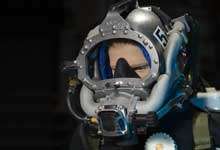Scientists take a deep dive for undersea warriors

Office of Naval Research (ONR) officials announced today new research support to develop a prototype diving helmet that could revolutionize diving missions—and provide greater safety for divers.
The announcement from ONR's TechSolutions program supports ongoing work to improve a diver's "rebreather" helmet system—a crucial piece of equipment that conserves breathing gas and combats the toxic gasses that impact divers breathing beneath the waves.
"Our undersea warriors deal with challenges that most of us will never have to face here on the surface," said ONR Executive Director Dr. Walter Jones. "We're working hard to get them the most cutting-edge technologies to accomplish their wide array of missions, and get them back to their ships safely."
The rebreather and helmet research is taking place at Naval Surface Warfare Center Panama City Division. The program developed a prototype life-support diving system that was announced last month.
The new research phase will lead to advanced testing to produce enhanced dive-ready prototypes, officials say.
The benefits to divers could be enormous. All divers encounter dangerous levels of toxic nitrogen and carbon dioxide gasses when breathing underwater, requiring a rebreather system to mitigate the toxicity. Navy divers use a breathing system called the Fly-Away Mixed Gas System, in which helium replaces the nitrogen that can lead to crippling, even fatal decompression sickness, known informally as "the bends."
While effective, it requires and expends large amounts of oxygen and helium in complicated mixtures.
However, helium availability has diminished in recent years, as demand has grown and production has slowed, and it has become more expensive and difficult to find. The new "hybrid" rebreather helmet from ONR TechSolutions allows divers to alternate between different breathing systems, and reduces the amount of helium needed.
This will allow Navy divers more diving opportunities than short supplies of helium currently permit.
Smaller vessels for missions will become a new possibility as well, since less gas will be needed for the divers—and hence less storage space required for gas canisters.
Finally, by optimizing the gas mixtures, the new rebreather will also extend the time divers can remain underwater safely in the event that primary breathing gas is interrupted.
"We're excited about the opportunity to make a positive impact on the mission capabilities of Navy divers," said ONR Command Master Chief Jesse Thomas. "Master divers have consistently said that one of their greatest needs is to have more options in the breathing apparatus, and to extend the window of safe diving time."
The work of the Navy diving community includes missions from underwater rescues to covert operations, and from explosive ordnance disposal to hull maintenance.
Undersea medicine—which includes the development of science and technology (S&T) aimed at optimizing submariner and diver performance—is designated an official National Naval Responsibility.
The rebreather work aligns with the recently released Naval S&T Strategy, which emphasizes National Naval Responsibilities as a key component of warfighter performance.
Provided by Office of Naval Research